The newspaper strip featured Hal Foster, Burne Hogarth, Russ Manning, Gil Kane — and so many MORE…
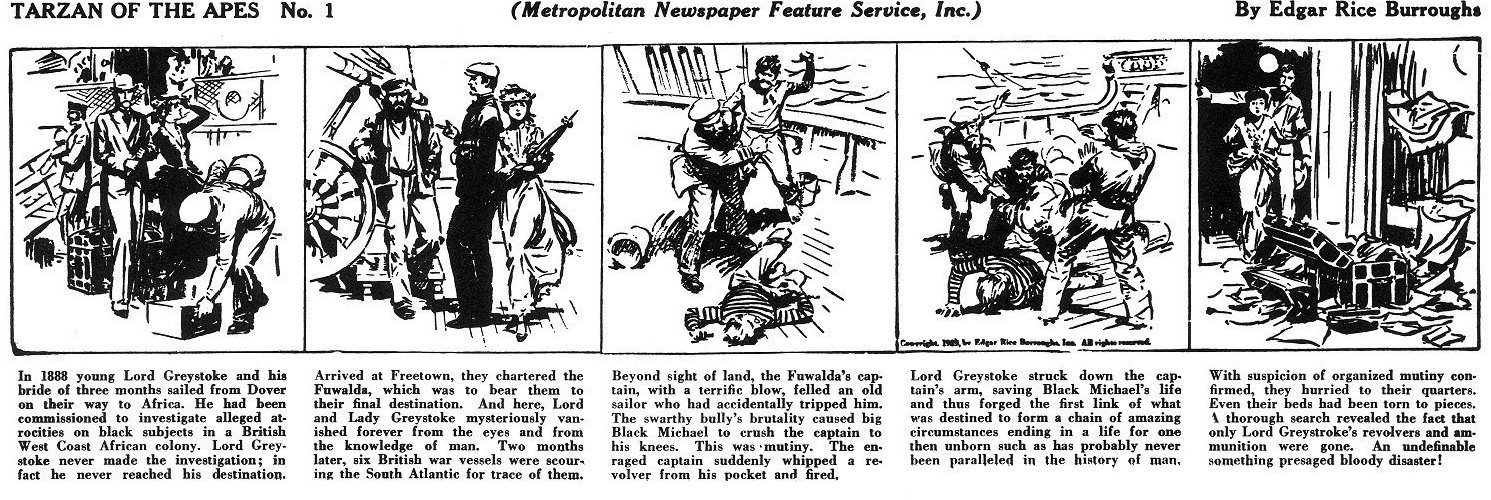
The first Tarzan strip, January 7, 1929
By PETER BOSCH
On January 7, 1929, the Tarzan comic strip made its first appearance in an American daily newspaper, intended as the start of a one-time, 60-strip adaptation of the Tarzan of the Apes novel by Edgar Rice Burroughs, with art by a young Harold R. Foster, drawing his first newspaper series. However, when the official Tarzan newspaper strip finally came to an end May 19, 2002, other artists had brought their own interpretation of the vine-swinging hero to it. In honor of the 95th anniversary of the first appearance of the strip, here is a salute to those 17 artists. (Not to neglect the writers, which included Burroughs, Don Garden, Rob Thompson, and also many of the artists below.)
—
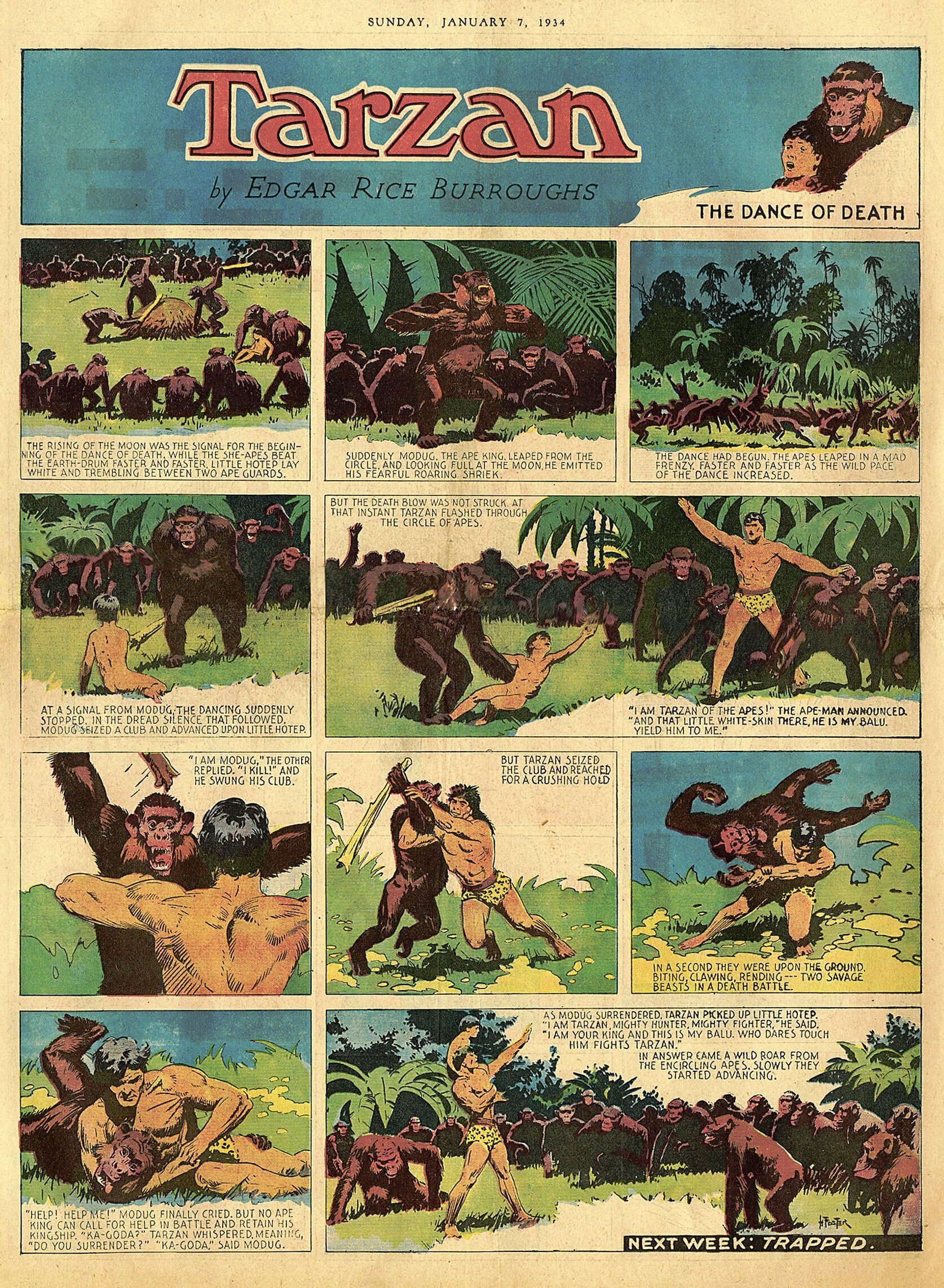
Hal Foster
As mentioned, Hal Foster drew the first Tarzan strip. The popularity of the 1929 feature prompted a regular newspaper strip that same year but Foster was no longer available, so United Feature Syndicate assigned the new 1929 daily, and then the Sunday strip in 1931, to Rex Maxon, a staff artist.
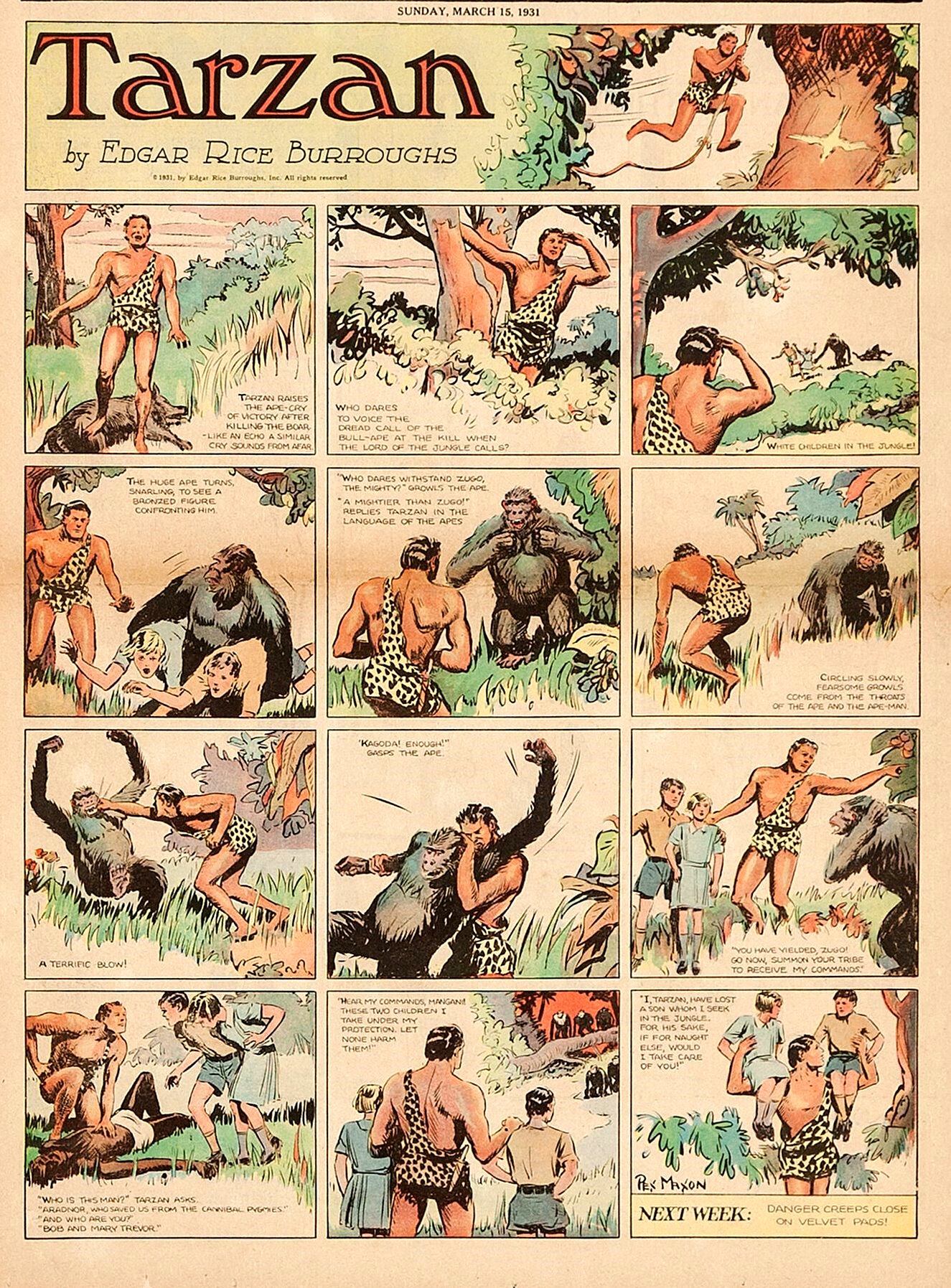
Rex Maxon
However, Burroughs was very dissatisfied with Maxon’s art and the syndicate was able to convince Foster to return to draw the Sunday strip for $75 a week. Foster remained on the Sunday from 1931 until mid-1937, at which time he left permanently to devote full time to his masterpiece, Prince Valiant, which had debuted a few months earlier in 1937.
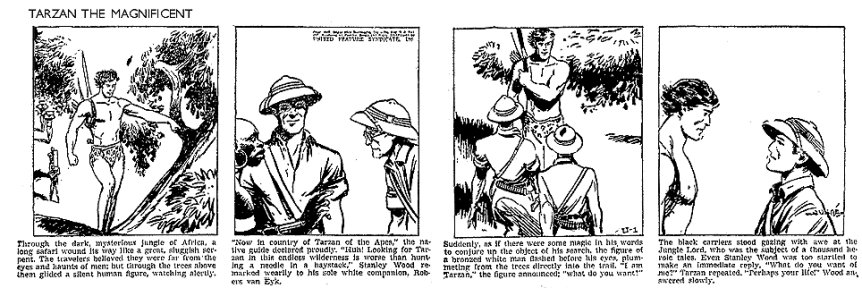
William Juhre
Though Maxon was off the Sunday, the syndicate kept him on the daily through 1947, except for June 1936 to January 1938 when William Juhre drew the strip. However, Burroughs felt Juhre was also a disaster and Maxon returned to drawing the strip.
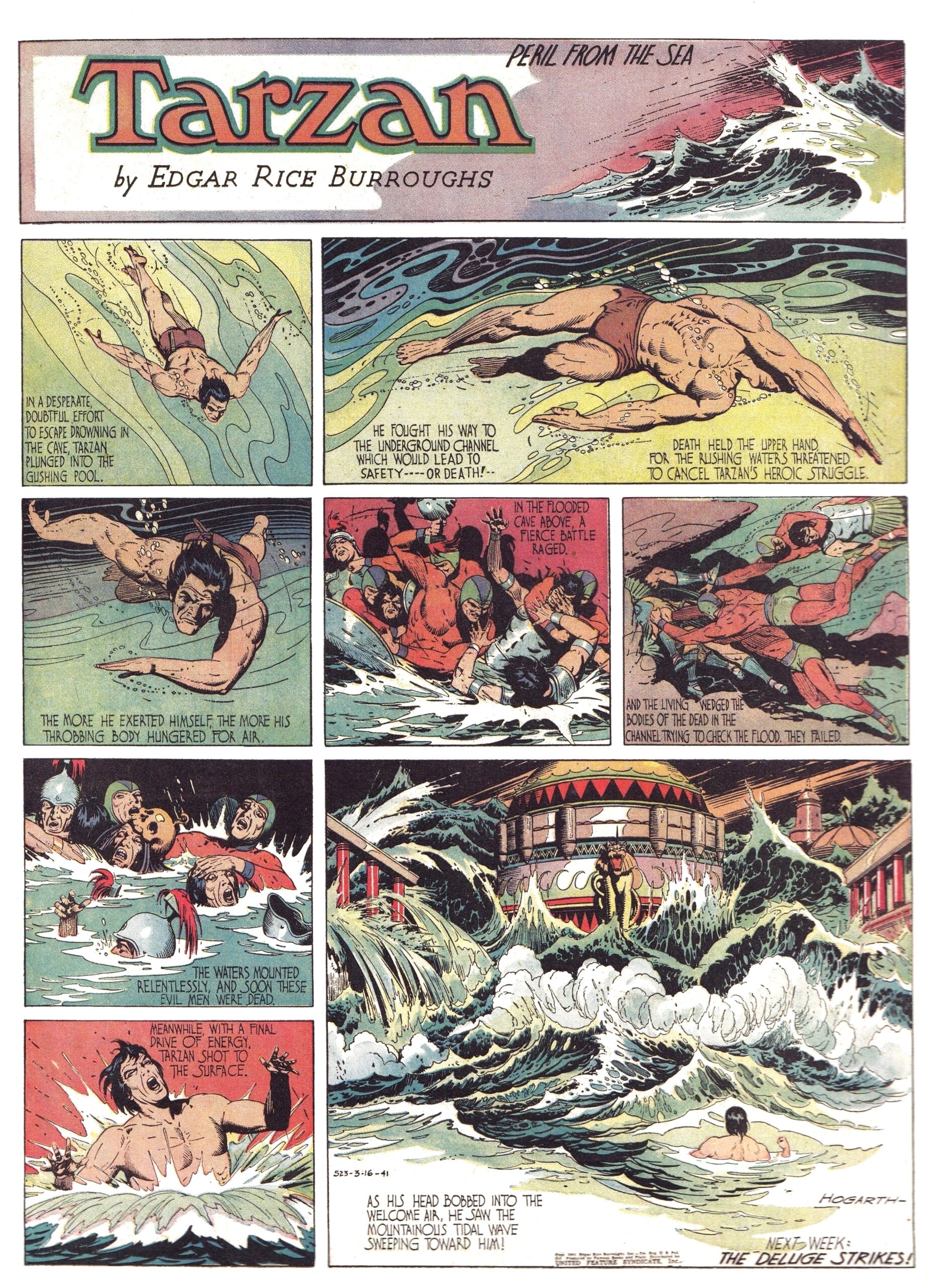
Burne Hogarth
In 1937, the most dynamic of all Tarzan artists, Burne Hogarth started drawing the feature… and no illustrator who followed could ever hope to achieve what Hogarth did on the Sunday strip. He continued through much of 1945, but then quit over a financial disagreement. He returned in 1947 with a raise in pay when they realized how much they needed him.
Hogarth also penciled a few weeks of dailies in late 1947 to help artist Dan Barry get started. (In that same year, Hogarth opened the Cartoonist and Illustrators School, later renamed the School of Visual Arts, in New York City.) (A side note: In 1972, Hogarth returned to the character of Tarzan with the first of two graphic novels — and Hogarth showed that he was not the artist he once was. He was now even better!)
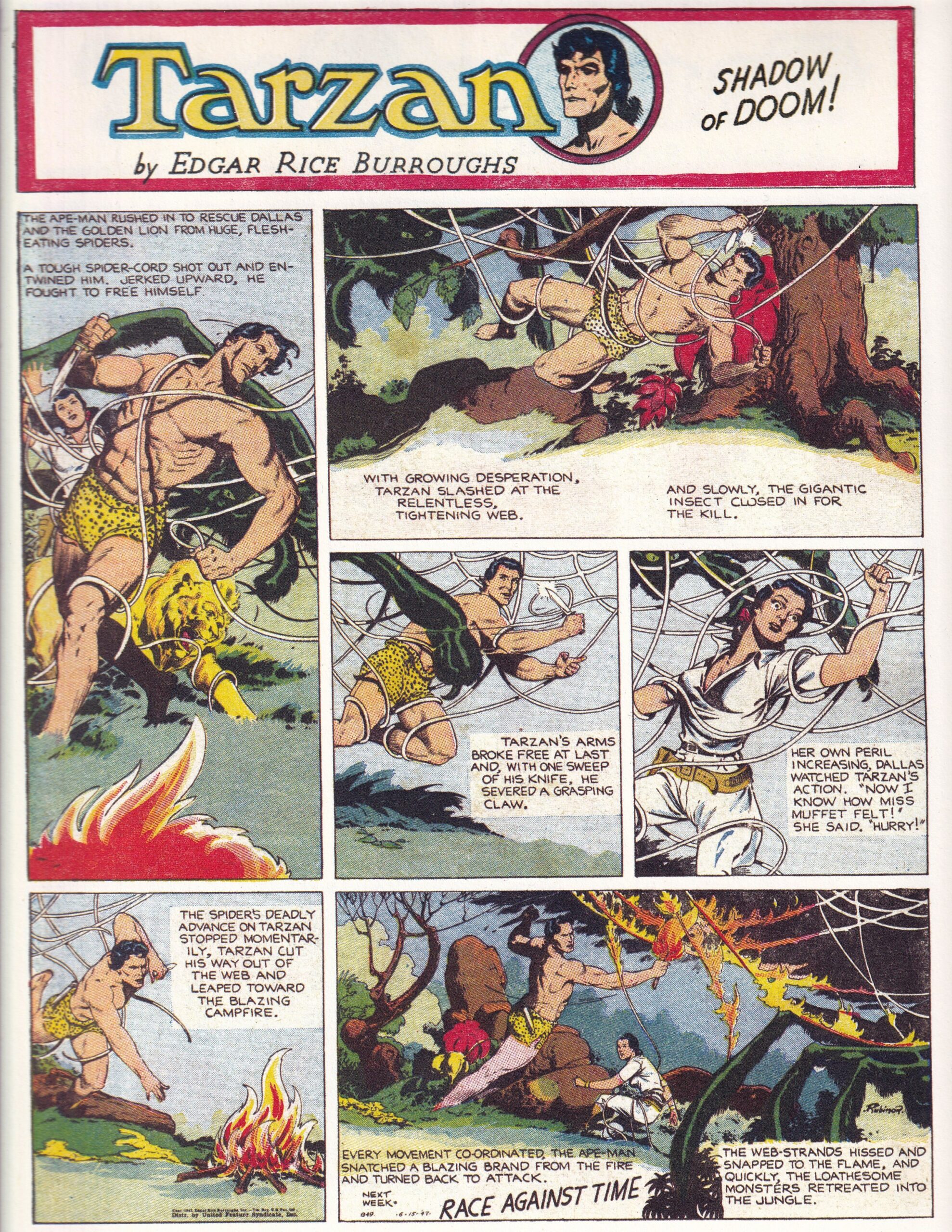
Ruben Moreira (“Rubimor”)
During that time from 1945 to 1947 when Hogarth was absent from the strip, Ruben Moreira (using the pseudonym of “Rubimor”) took over the art for the Sunday strip. (Moreira would have a great history in comic books, starting with Fiction House and with Quality in the Forties and grew even more successful in the Fifties at DC Comics drawing mystery, science-fiction and suspense titles.)
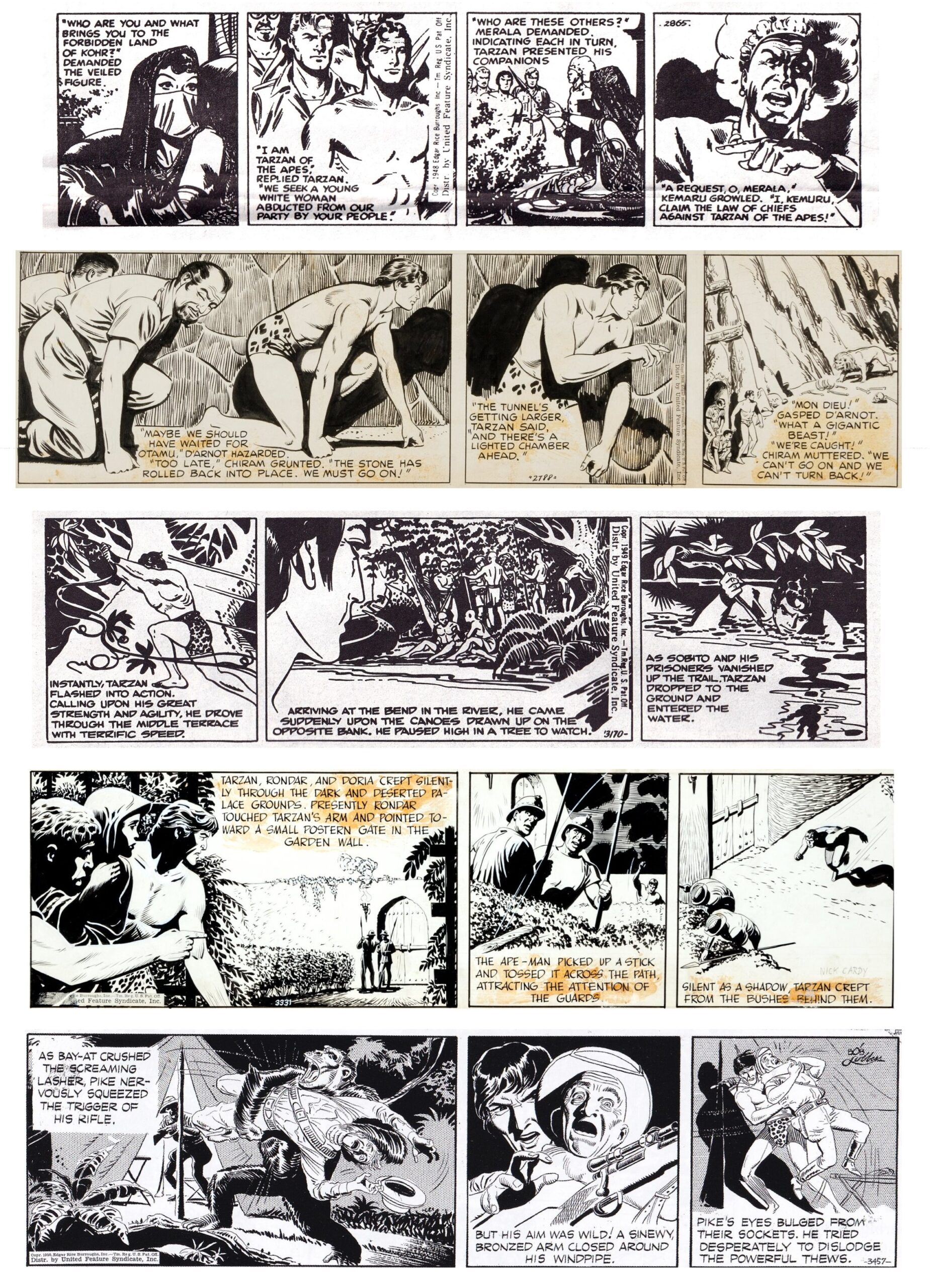
From top to bottom, examples of Dan Barry, John Lehti, Paul Reinman, Nick Cardy and Bob Lubbers
Meanwhile, Dan Barry (with assists from his brother Sy) worked on the Tarzan dailies for just over a year between 1947 and 1948 after Rex Maxon left. (A few years later, in 1951, Barry took over the dailies of another iconic strip, Flash Gordon, while Sy Barry would eventually find a home in the jungles with The Phantom newspaper strip.) Dan Barry was also a success at DC Comics during the 1950s and his art became the house style that other artists were required to imitate.
After Dan Barry, John Lehti was given a chance to draw the Tarzan daily strip for three and a half months in 1948, but was replaced by Paul Reinman, another of Hogarth’s “assistants” (the syndicate’s term for his hires) from 1949 to 1950. (Reinman’s career in comics, prior to and after Tarzan, was quite varied, including at DC, Timely/Atlas/Marvel, where he inked Jack Kirby for the first issues of The Incredible Hulk and The X-Men. In the mid-1960s, he and Jerry Siegel created The Mighty Crusaders for Archie Comics.)
Nick Cardy came aboard in 1950 but it was just for a few months. Bob Lubbers, one of the great “good girl art” masters of the comic books, was next through the revolving door and he brought with him that talent to the Tarzan daily and Sunday strips from 1950 through his stay in 1954. (For more of Lubbers’ career, including drawing Tarzan, click here.)
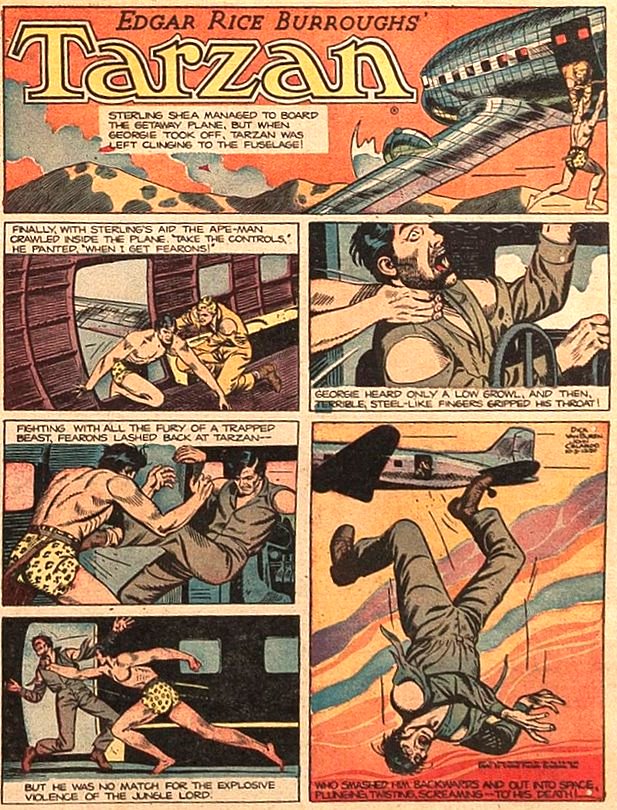
John Celardo
Then came John Celardo, who stayed with the daily from 1954-1967 and the Sunday from 1954-1968. He will likely be remembered by most Baby Boomers from their time reading the strip in their youth. However, with a strip like Tarzan, change would inevitably come again. And a magnificent change it was!
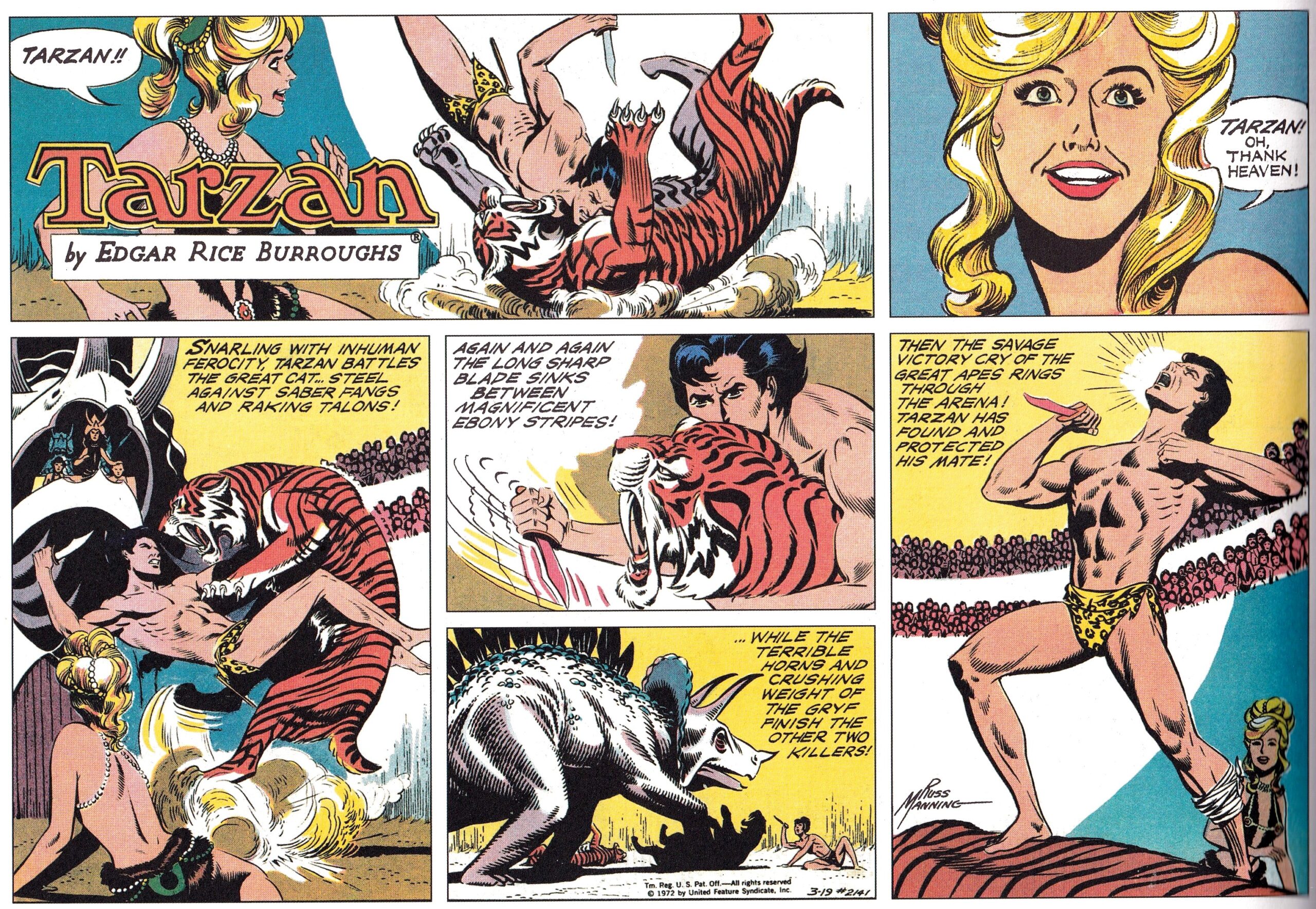
Russ Manning
Burne Hogarth may have been the most dynamic artist ever to grace the Tarzan strip, but Russ Manning drew the most beautiful art of any of the illustrators listed here. Beginning with the dailies in 1967 and then the Sunday in 1968, he changed the entire feel of the strip. In order to concentrate on the Sundays, he gave up the daily strip in 1972 but, instead of replacing him with a new artist, the syndicate chose to run reprints of older stories for a time and then cancelled the daily completely. (For a much deeper dive on what Manning brought to Tarzan, please check out my appreciation of him here.)
Manning continued drawing the Sunday Tarzan through 1979, at which time he left to focus completely on the new Star Wars strip.
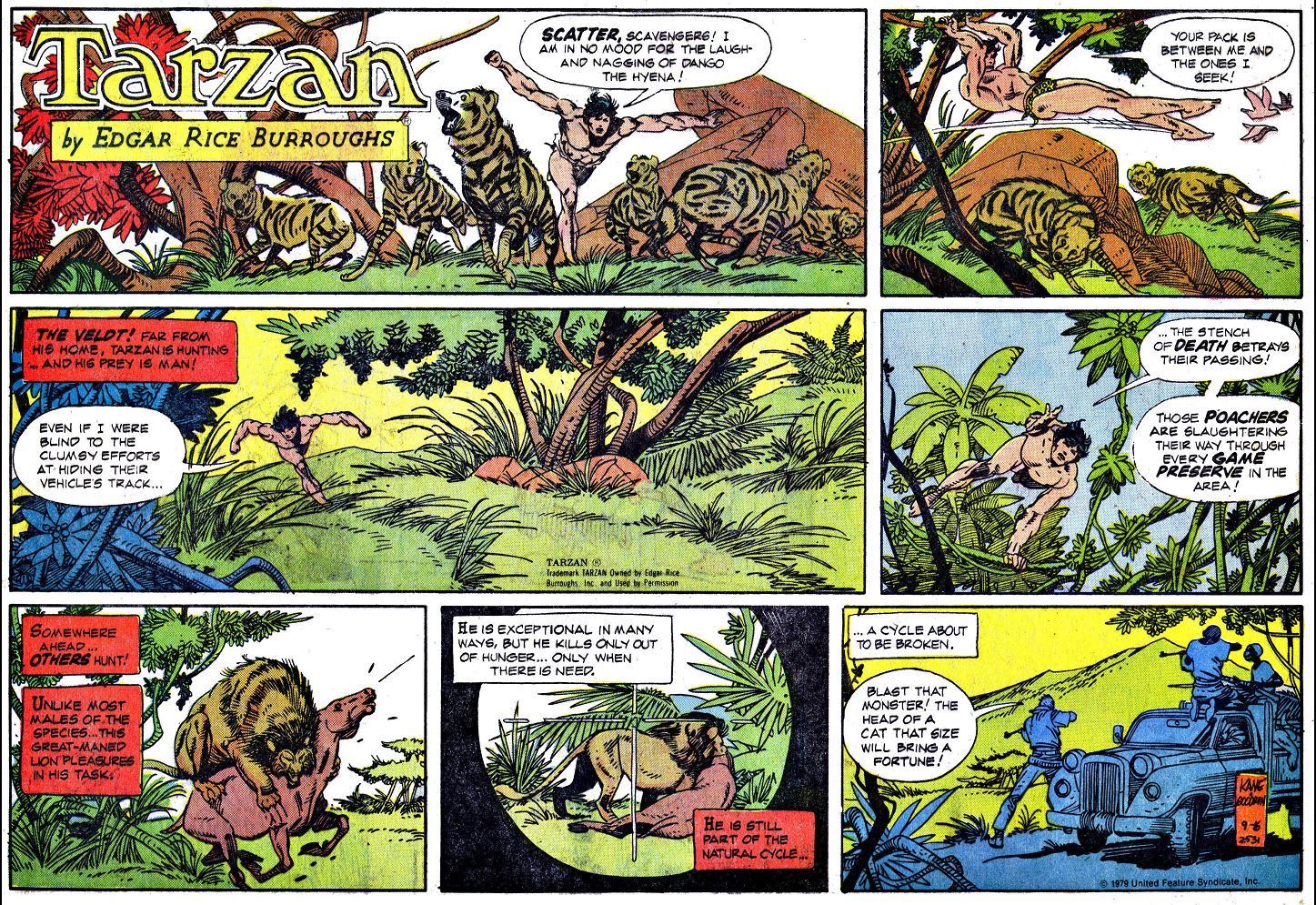
Gil Kane
Following Manning, Gil Kane took over drawing the Sunday Tarzan but he only lasted two years, from 1979 to 1981. Likewise, Mike Grell’s time on the strip was just from 1981 to 1983.
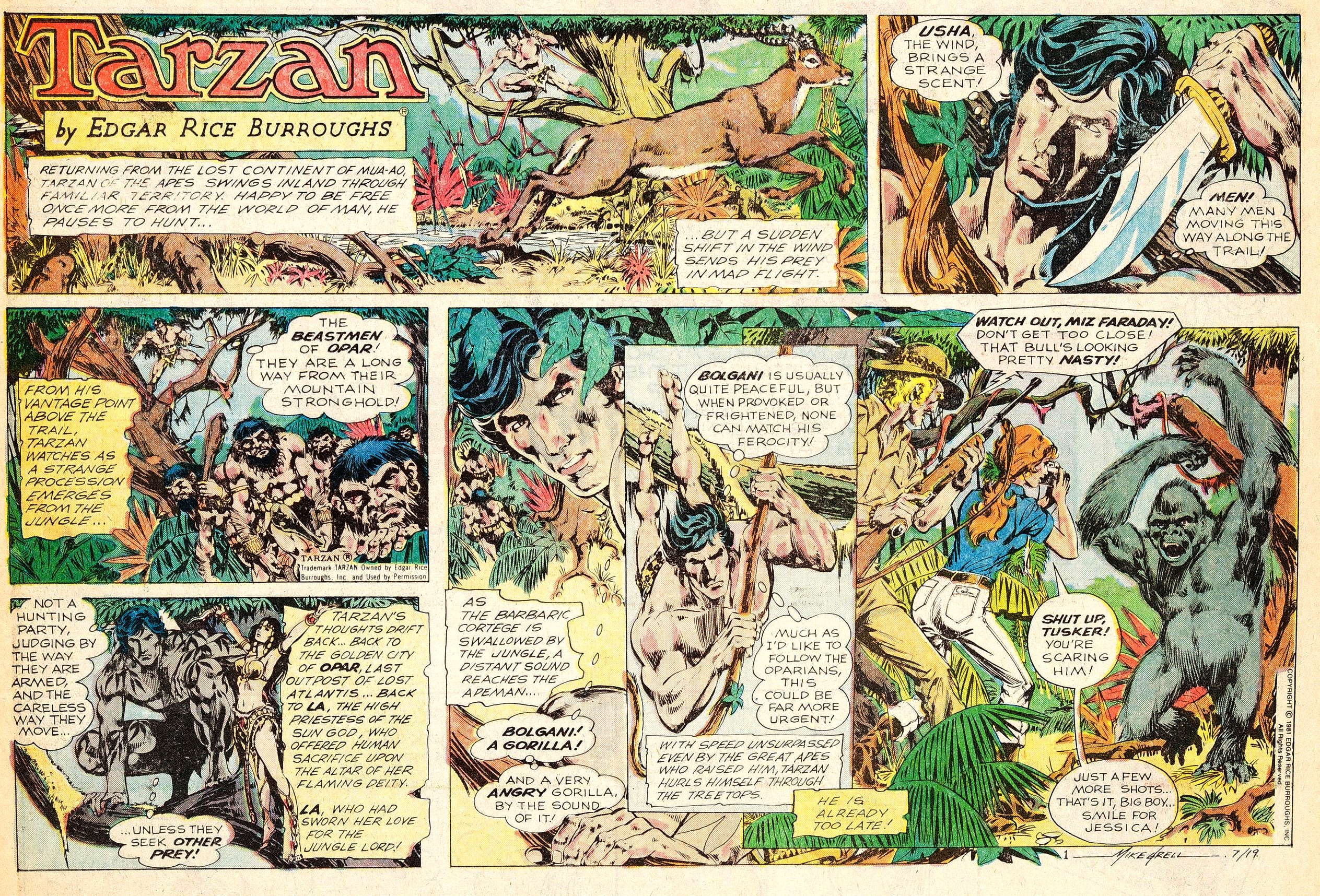
Mike Grell
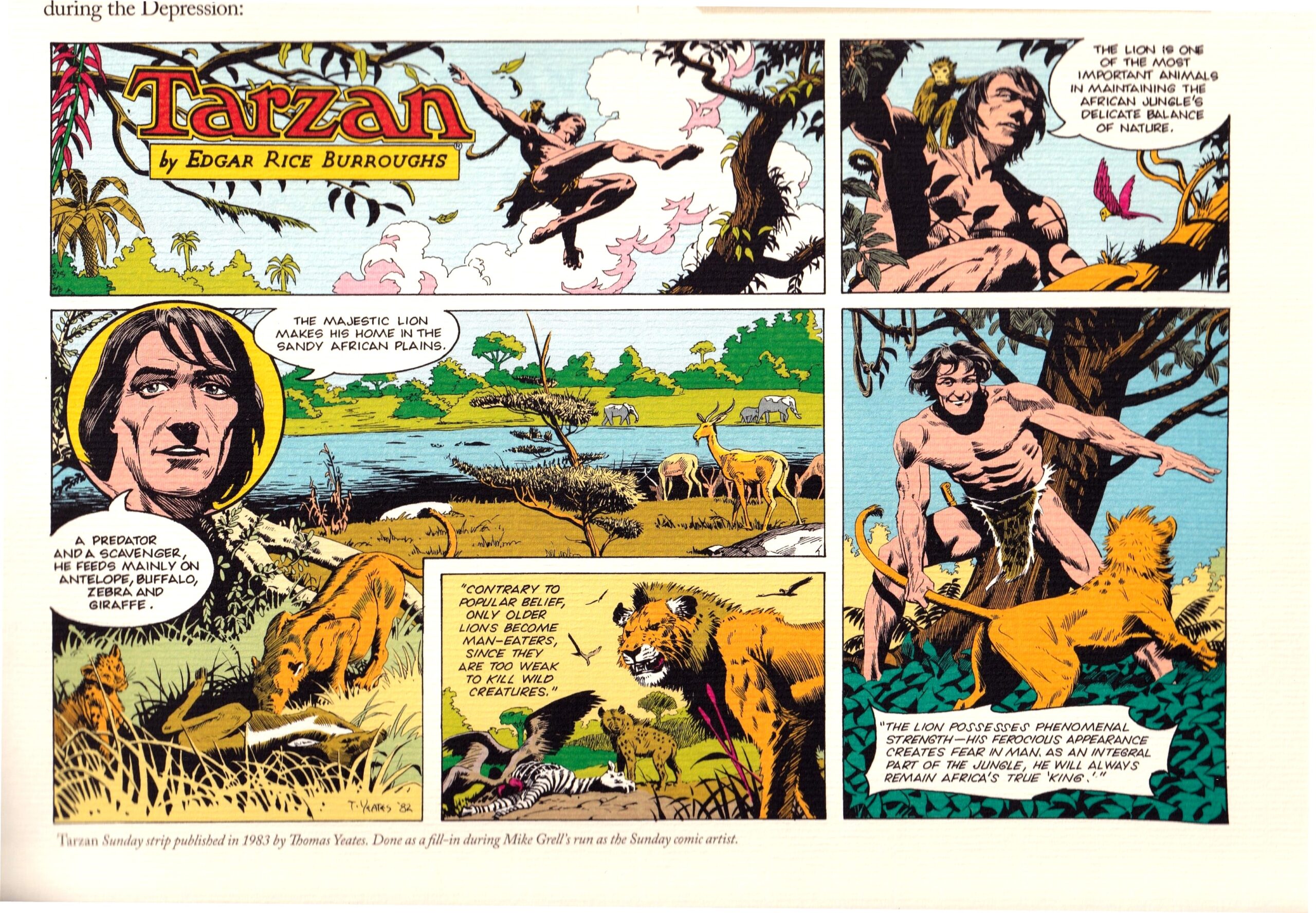
However, of all the artists discussed, Thomas Yeates holds the absolute record for the shortest time drawing the newspaper Sunday — just one week, February 18, 1983, when he supplied a filler for Grell between one story’s end and the start of another. (Thankfully, Yeates did get to draw Tarzan for various comic book series from Dark Horse Comics and Malibu.)
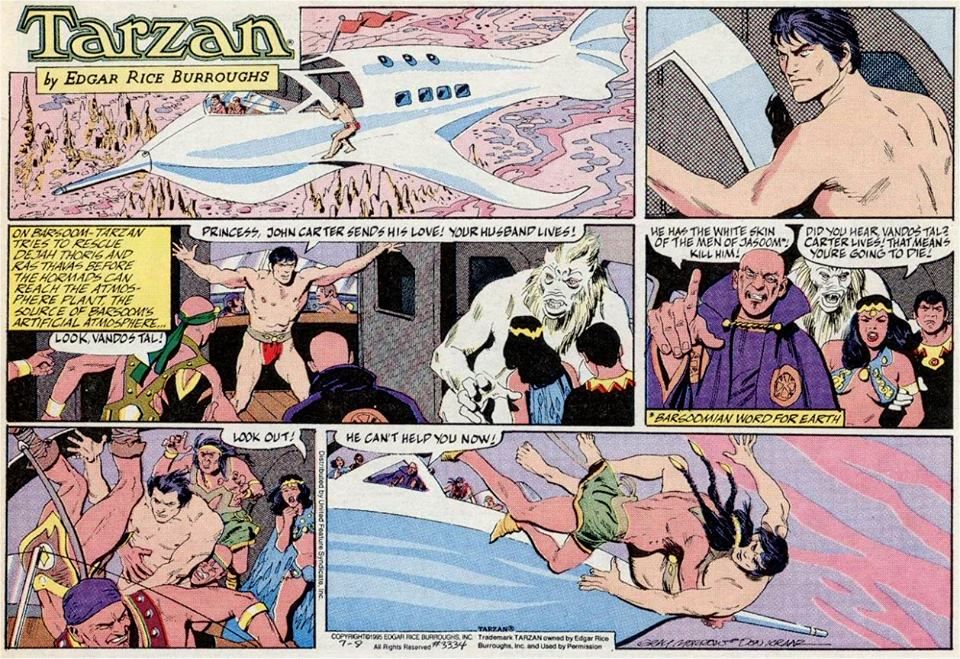
Gray Morrow
Gray Morrow, on the other hand, drew the feature for one of its longest periods, from 1983 to 2001.
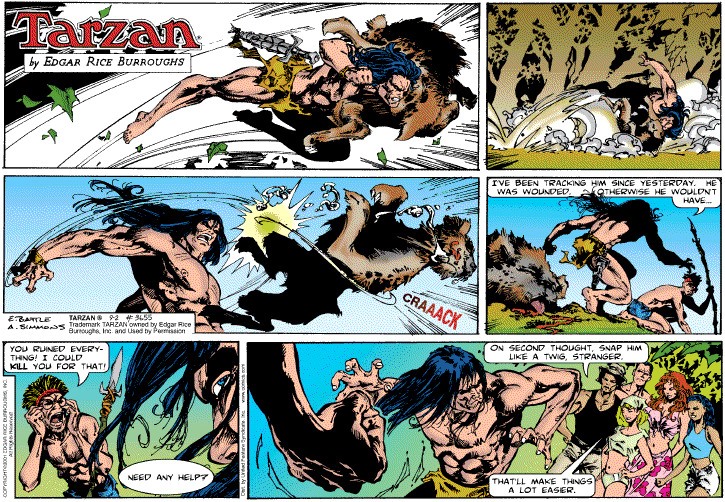
Eric Battle
The last artist to tackle the newspaper strip was Eric Battle, starting in 2001 but his run – and that of the strip itself – ended on May 19, 2002.
After 73 years, the Tarzan newspaper strip was then no more (though there was a webcomic that would come afterward, written by Roy Thomas and drawn by Tom Grindberg). It was actually symbolic of the change of newspaper comic-strip pages from “must read” to “do comics still appear in newspapers?” Maybe, maybe not. But as long as the need for excitement exists, all it takes is one person to dream and to bring that dream to millions of others who still crave wild adventures with an ape man like Tarzan.
—
NOTE: All strips copyright Edgar Rice Burroughs Inc.
—
MORE
— JOE JUSKO’s TOP 13 Painted TARZAN COVERS — RANKED. Click here.
— WORLD’S GREATEST TOYS DIGEST #6 Spotlights MEGO TARZAN. Click here.
—
13th Dimension contributor-at-large PETER BOSCH’s first book, American TV Comic Books: 1940s-1980s – From the Small Screen to the Printed Page, was published by TwoMorrows. He is currently at work on a sequel, about movie comics. Peter has written articles and conducted celebrity interviews for various magazines and newspapers. He lives in Hollywood.


January 7, 2024
Dark Horse has reprinted the Foster and Manning strips, and Titan released the Hogarth strips. But so Mano of these other runs remain uncollected. Which is a shame. I’m especially jonesing for a Grell collection and certainly wouldn’t say no to the Kane or Morrow runs either…
January 7, 2024
What? No Frank Frazetta? No Neal Adams? No Joe Kubert? No John Buscema?
January 7, 2024
All comic strips, Pete.
January 7, 2024
This is focusing on the newspaper strip, which none of those great artists worked on.
January 7, 2024
Hi, Peter. In the first paragraph, I noted this article is in honor of the comic strip appearing 95 years ago and it is saluting the 17 artists who drew the strip over the years.
January 11, 2024
Very detailed breakdown